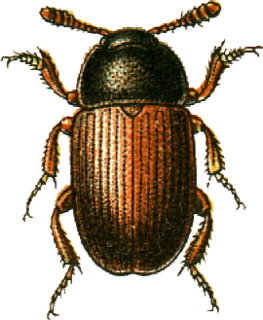In biological classification, a subfamily is an auxiliary (intermediate) taxonomic rank, next below family but more inclusive than genus. Standard nomenclature rules end subfamily botanical names with "-oideae", and zoological names with "-inae".

The Curculionidae are the family of the "true" weevils. They are one of the largest animal families, with 6,800 genera and 83,000 species described worldwide.
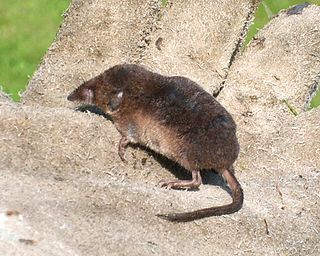
Eulipotyphla is an order of mammals suggested by molecular methods of phylogenetic reconstruction, and includes the laurasiatherian members of the now-invalid polyphyletic order Lipotyphla, but not the afrotherian members. Lipotyphla in turn had been derived by removing a number of groups from Insectivora, the previously used wastebasket taxon.

Colubridae is a family of snakes. With 524 genera and approximately 1,760 species, it is the largest snake family, and includes just over 51% of all known living snake species. The earliest species of the family date back to the Oligocene epoch. Colubrid snakes are found on every continent except Antarctica.

The Muroidea are a large superfamily of rodents, including mice, rats, voles, hamsters, gerbils, and many other relatives. They occupy a vast variety of habitats on every continent except Antarctica. Some authorities have placed all members of this group into a single family, Muridae, due to difficulties in determining how the subfamilies are related to one another. The following taxonomy is based on recent well-supported molecular phylogenies.

The Gelechiidae are a family of moths commonly referred to as twirler moths or gelechiid moths. They are the namesake family of the huge and little-studied superfamily Gelechioidea, and the family's taxonomy has been subject to considerable dispute. These are generally very small moths with narrow, fringed wings. The larvae of most species feed internally on various parts of their host plants, sometimes causing galls. Douglas-fir (Pseudotsuga) is a host plant common to many species of the family, particularly of the genus Chionodes, which as a result is more diverse in North America than usual for Gelechioidea.
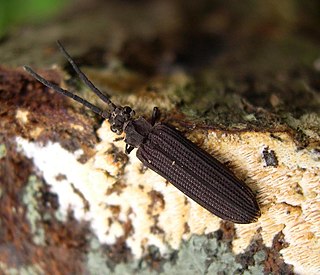
The Archostemata are the smallest suborder of beetles, consisting of fewer than 50 known species organised into five families. They are an ancient lineage with a number of primitive characteristics. They are similar in morphology to the first beetles, which appear in the fossil record about 250 million years ago. Antennae may be thread-shaped (filiform) or like a string of beads (moniliform). This suborder also contains the only paedogenic beetles, Micromalthus debilis.

Asphodelaceae is a family of flowering plants in the order Asparagales. Such a family has been recognized by most taxonomists, but the circumscription has varied widely. In its current circumscription in the APG IV system, it includes about 40 genera and 900 known species.
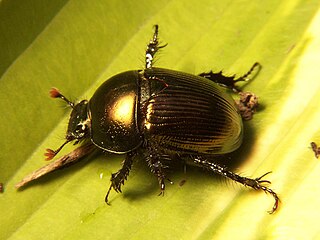
Geotrupidae is a family of beetles in the order Coleoptera. They are commonly called earth-boring dung beetles. Most excavate burrows in which to lay their eggs. They are typically detritivores, provisioning their nests with leaf litter, but are occasionally coprophagous, similar to dung beetles. The eggs are laid in or upon the provision mass and buried, and the developing larvae feed upon the provisions. The burrows of some species can exceed 2 metres in depth.

The Lasiocampidae are a family of moths also known as eggars, snout moths, or lappet moths. Over 2,000 species occur worldwide, and probably not all have been named or studied.

Asparagaceae is a family of flowering plants, placed in the order Asparagales of the monocots. Its best known member is Asparagus officinalis, garden asparagus.
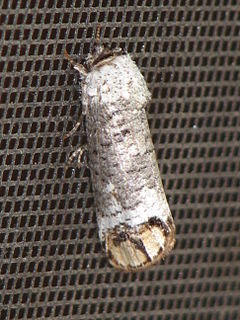
The Cossidae, the cossid millers or carpenter millers, make up a family of mostly large miller moths. This family contains over 110 genera with almost 700 known species, and many more species await description. Carpenter millers are nocturnal Lepidoptera found worldwide, except the Southeast Asian subfamily Ratardinae, which is mostly active during the day.

The Megalopodidae are a small family of leaf beetles, previously included as a subfamily within the Chrysomelidae. One of its constituent subfamilies, Zeugophorinae, which contains a single genus, has also frequently been treated as a subfamily within Chrysomelidae. The family contains approximately 30 genera worldwide, primarily in the nominate subfamily Megalopodinae, and mostly circumtropical.
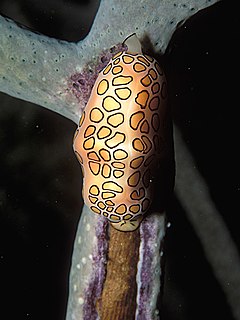
Ovulidae, common names the ovulids, cowry allies or false cowries, is a family of small to large predatory or parasitic sea snails, marine gastropod molluscs in the superfamily Cypraeoidea, the cowries and the cowry allies.

The Alethinophidia are an infraorder of snakes that includes all snakes other than blind snakes and thread snakes. Snakes have long been grouped into families within Alethinophidia based on their morphology, especially that of their teeth. More modern phylogenetic hypotheses using genetic data support the recognition of 19 extant families, although the taxonomy of alethinophidian snakes has long been debated, and ultimately the decision whether to assign a particular clade to a particular Linnaean rank is arbitrary.

The coneweb spiders of the family Diguetidae are six-eyed haplogyne spiders that live in tangled space webs. They fashion a cone-like central retreat in which they hide and lay eggs. The family is small and is confined to the New World, where it is usually found in deserts. Members of the genus Diguetia usually build their webs in shrubs or between cactus pads. Although they have the same eye arrangement as the venomous recluse spiders, none of these genera are known to be harmful to humans.

Velutinoidea is a superfamily of sea snails, marine gastropod molluscs in the clade Littorinimorpha.

Ixoroideae is a subfamily of flowering plants in the Rubiaceae family and contains about 4000 species in 27 tribes.

Colubroidea is a superfamily of snakes in the clade Colubroides that include Colubridae and a few other related families. In addition to colubrids, the past Colubroidea used various other caenophidian snakes like cobras and vipers as these snakes form a clade. However these same studies also found in support of dividing the family Colubridae into several distinct, but related, families. Zaher et al. (2009) proposed to redefine Colubroidea for colubrids and related families, while naming Colubroides for the group containing vipers, cobras as well as colubroids.

Olfactory receptor family 4 subfamily F member 5 is a protein that in humans is encoded by the OR4F5 gene.

